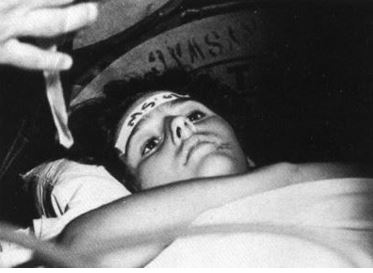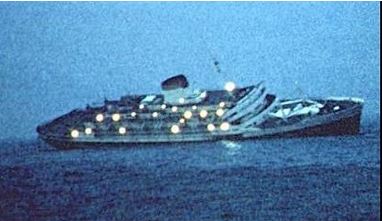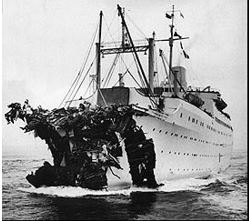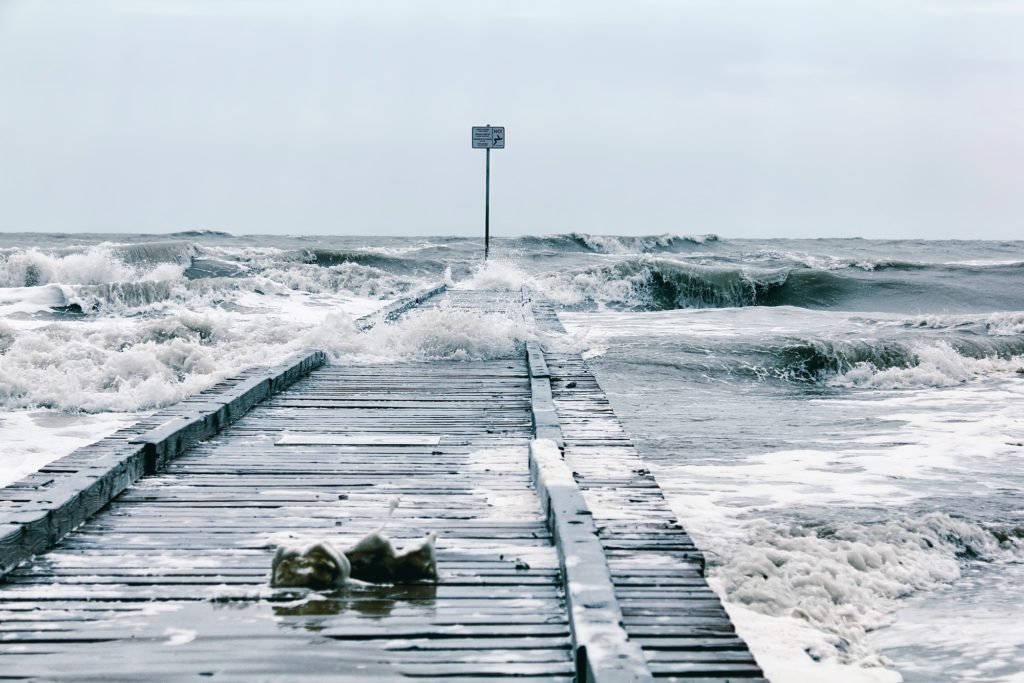During the late evening of July 25, 1956, two cruise ships collided in the North Atlantic well south of Nantucket Island, Massachusetts, in a dense fog. The disaster, which claimed over fifty lives, triggered one of the largest maritime rescues in recorded history. The tragic story captured the interest of news media and the nation at that time.
From the time that I was very young, I was not only a weather fanatic but a “news junkie”, as well. I remember so much talk about the Andrea Doria but it couldn’t have possibly been at the time of the collision because I was only 31/2 years old when it occurred.
The Andrea Doria
As World War Two ended, Italy was crushed both economically and psychologically. Italy was desperate to regain a sense of national pride. One of the ways Italy attempted to accomplish this was to commission the construction of two world-class cruise ships. They would be state of the art with all the “bells and whistles”.
The ships were named Andrea Doria and Christoforo Columbo (named after Christopher Columbus).
Andrea Doria was a famous Italian and his fame in Italy is considered on par with for George Washington here in the U.S. Doria fought in many maritime battles during the early 1500s and was credited as the first mariner to sail against the wind.
Italy had actually named a number of ships after Andrea Doria which included a battleship that was launched in 1913.
Making its maiden voyage across the Atlantic in 1953, the Andrea Doria did indeed have all the “bells and whistles”. The ship was nearly 700 feet long and weighed 29,000 tons. It included three outdoor swimming pools, famous paintings, and surrealist murals. There was also a life-sized bronze statue of Andrea Doria, as well.
There were a number of safety features that were included. It had a double hull and was divided into 11 watertight compartments Any two of these could be filled with water and the ship would still be safe. There were six steel lifeboats and two seventy-person motorboats with inboard radio transmitters. It also had a state-of-the-art radar warning system. The ship was deemed “unsinkable”.
There were a few concerns, however. On its maiden voyage in 1953, it was hit by a large wave off the coast of Nantucket Island. The list (the degree to which a ship leans or tilts, to either port or starboard at equilibrium with no external forces acting upon it) is greater when the fuel tanks are closer to empty. In that case, Andrea Doria’s tilt exceeded safety standards.
Andrea Doria completed 100 TransAtlantic crossings from 1953 to 1956. The ship departed from Genoa, Italy on July 17, 1956, and made three stops around the Meditteranean before partaking on a nine-day ocean voyage across the Atlantic with a crew of 572 and 1,134 passengers which included immigrants, business people, and vacationers.
A Catastrophic Collision
On July 25th, SS Andrea Doria entered the more heavily trafficked waters off the coast of New England. On that Wednesday the Swedish cruise ship M.S. Stockholm departed the Port of New York on its way to Gothenburg, Sweeden, just before noon. Stockholm was one of the smaller cruise ships of that time (524 feet) and it accommodated 548 passengers. The ship’s prow (the most forward part of a ship that cuts through and sticks out above the water) was fitted with a steel rake designed to smash through thick ice.
That day was a very warm and humid one when Stockholm departed but the skies were mainly clear and visibility was good. As Andrea Doria continued to move toward the U.S. East Coast it began to run into patches of fog. The fog became more prevalent as the afternoon progressed into the evening. Fog around the New England Coast is not unusual during the summer months, in an area where warm and cold ocean currents come together. In addition, when humidity levels are high, the cooler ocean waters enhance condensation at lower levels of the atmosphere.
Captain Piero Calamai of Andrea Doria reduced his forward speed only slightly when he began to move toward the thick fog. The standard rules indicate that captains should slow ships to a crawl under these conditions, It was common, however, for captains to not adhere to the rules if they were running behind on time.
Captain Calmai did activate the fog-warning whistle and closed the watertight doors. Meanwhile, Stockholm continued to progress under clear conditions and the crew was unaware of the fog that they would soon encounter. The air temperature at that time was reported to be around 70 degrees,
At about 10:45 p.m. Andrea Doria’s radar showed a blip on the screen which was the Stockholm. The Stockholm saw the Andrea Doria on its radar, as well, as it moved into a much denser fog. It was only after a later investigation that there was a major problem with the radar on Stockholm and it misplaced Andrea Doria’s position.
Instead of avoiding each other, both ships made maneuvers that put them on a direct collision course. Around 11:10 p.m. Captain Calarmi saw the Stockholm’s lights through the thick fog.
According to an article at www.history.com one of the officers cried out “She’s coming right at us”.
The steel rake, mentioned earlier, of Stockholm, crashed into the Andrea Doris with incredible force and penetrated about 30 feet into its hull. It stayed lodged in the Andria Doria for several seconds before breaking loose and leaving a massive hole.
Needless to say, panicked passengers on the Andrea Doria created a scene of chaos. Several saw the light of the Stockholm just before the collision. According to many accounts, the sound of the collision was deafening.
Lights went out and there was a smell of burning electrical circuits and smoke filled the hallways. Bottles were thrown all over and there was crashing glass all around. There were screams of panic. Many passengers just held on to each other as they made their way to the deck, some with lifejackets in their hands.
A Google map indicating the location of the collision of Andrea Doria and Stockholm late on July 25, 1956.
It was later determined that at the moment of the collision, 46 people were crushed to death. A four-year-old Italian girl was dropped by accident head-first into a lifeboat and her father died of a heart attack later. Another woman died trying to board a lifeboat.
In the midst of the tragedy, there was a “miracle” A fourteen-year-old girl, Linda Morgan, who lost her mother and sister upon impact, was thrown out of her bed and onto the deck of Stockholm. She did suffer a broken arm but she survived. Meanwhile, five crew members perished on board Stockholm at the moment of impact. Those were the only deaths reported on that ship.
A photo shows 14-year-old Linda Morgan being medically treated after being thrown from her bed on Andrea Doria to the deck of the Stockholm after the collision. Photo Credit-Wikipedia-Public Domain.
After the collision, passengers boarded lifeboats from Andrea Doria and Stockholm. Distress signals were issued by the captains.
Andrea Doria began to “list” after the crash to over twenty degrees. That allowed the ship to take on large amounts of water above the watertight compartments which were only fifteen feet high. The ship eventually sank the next morning, but the slowness of that occurrence saved hundreds of lives.
A photo showing a severely crippled Andrea Doria shortly before sinking in the Atlantic after a tragic collision with the cruise ship Stockholm on July 26, 1956. Photo Credit-Wikipedia-Public Domain.
A freighter, Cape Ann, was the first ship to answer the distress calls. A U.S. Navy transport ship then came on the scene a destroyer and Coast Guard cutter followed.
The rescue effort was one of the largest in maritime history. By 5:30 a.m. all of Andrea Doria’s survivors were rescued, some went to Stockholm and others on ships like Isle de France.
Captain Calamai was ready to go down with the ship but when his crew refused to leave him behind, he boarded the last lifeboat, Calamai would never command a cruise ship again. At 10:09 a.m., on July 26th with the rescue fleet on the way to New York, Andrea Doria disappeared from view and sank to the bottom of the ocean.
Stockholm managed to return to the Port of New York under its own power.
This July 26, 1956 photo shows a severely damaged Stockholm after its collision with Andrea Doria. Photo credit-Wikipedia- Public Domain.
Epilogue
There was extensive news coverage of this tragedy at the time and for many years to come. As opposed to the Titanic in 1912, there was both radio and television in 1956. Also, the collision occurred proximate to the U.S. Coast with New York as the point of departure for Stockholm and the destination for Andrea Doria.
Many family and friends of the passengers gathered at the Port of New York on July 26th awaiting news of their loved ones. Fortunately, most survived.
On his daily broadcast, ABC News commentator Edward P. Morgan reported a detailed account of the collision. What he didn’t tell his listeners was that his daughter, Linda, was a passenger on the Andrea Doria and she was feared dead.
Linda Morgan dubbed the “miracle girl”, regained consciousness while on Stockholm where she was thrown. Born in Mexico City, her first words in Spanish were: I was on the Andrea Doria where am I now?”
She was taken to St. Vincent’s Hospital in New York City where Sister Loretta Bernard gave her a “Miracle Medal of Our Lady”.
Linda suffered “survivor’s guilt’ throughout her life. In 1968 she married Phill Hardberger. They moved to San Antonio. Texas, in 1970. Linda became a curator at an art museum and Phil became mayor of San Antonio in 2005. Linda passed away in 2009.
In the movie “On The Waterfront” in 1954, Andrea Doria appeared briefly along the Hudson River during a scene that featured Marlon Brando’s character, Terry Malloy.
In 1976, 20 years after the collision there was a documentary produced about Andrea Doria. A made-for-TV movie “The Sinking of Andrea Doria” appeared in 1996 around the 40-year anniversary.
Sixteen people have lost their lives since 1956 exploring the wreckage of the Andrea Doria which rests under 240 feet of water.
An article published at thoughtcatalogue.com addressed the issue of the blame for the collision Since the ship was close to arriving in the USA, Doria’s captain neglected to fill the empty fuel tanks on one side of the ship with seawater, which would have provided the balance to prevent the liner from tilting as severely as it did.
Because Doria was behind schedule, its captain maintained a high speed rather than the slower speed mandated when one’s ship is caught in the fog.
In the final minutes before the collision, the Stockholm turned sharply to its right, while the Dorea turned to its left, effectively causing the crash. If both ships had remained on their courses without these sudden turns, the crash never would have occurred.
Due to faulty radar equipment aboard Stockholm, the captain mistakenly thought Andrea Doria was 14 miles away rather than four miles away.
After a one-million-dollar repair, Stockholm returned to service. it was sold to East Germany in 1960 and then sold to Italy. It was renamed, Athena. In December of 2008, Athena was attacked by pirates in the Gulf of Aden A U.S. Navy P-3 Orion aircraft chased the pirates away.
The ship’s name was changed to Astoria and it was registered to Portugal. After seventy-five years, in service, the ship made its final voyage and it was then sent to a scrapyard in early 2023.






